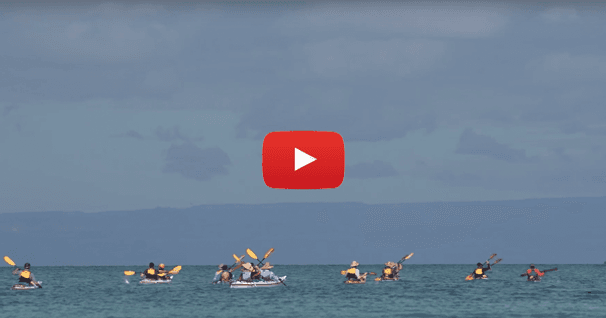Going Straight - Rudder or Skeg?
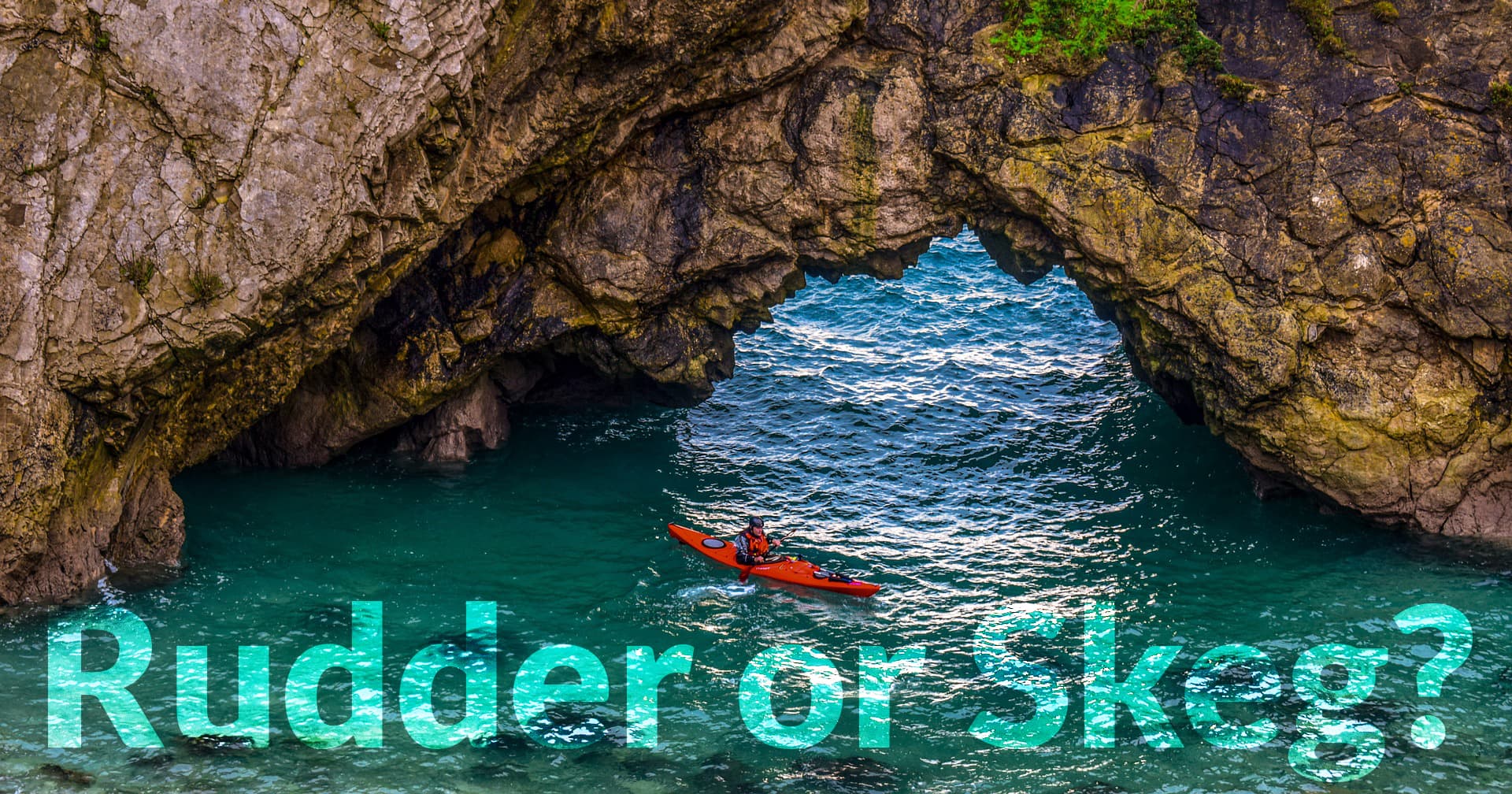
Ask someone not yet savvy to all the nuances of handling a touring/recreational kayak what a rudder is used for and you will probably hear "for steering" as the most common response.
Indeed, for as defined by the International Maritime Dictionary, a rudder is a "device for steering and maneuvering." For sea kayakers, however, that definition would better serve if it were modified to read "a device to aid in maneuvering" – and let it go at that.
It's not uncommon to see kayakers launching for an afternoon paddle quickly deploy their rudders immediately upon leaving shore and then spending the entire trip sloshing the rudder from side to side as they "steer" their kayak along. For many, this becomes a lifelong routine that never enables them to enhance their paddling strokes to a point that steering is a function of correct paddling strokes and not the constant use of a long, narrow fin swishing through the water off the back end of one’s boat.
Even the most perfectly-designed, straight-tracking kayak can go off course when the dynamics of wind, wave and weight distribution come into play. The most common of these is a term called "weathercocking". That's when the wind, blowing from the side during your forward motion, causes the boat to turn into the wind – it cocks into the wind or weather side (as opposed to the downwind, lee side) – hence the name.
For most paddlers, kayaking against the wind coming from either side means one's boat is going to be forced off course depending upon the dynamics at hand. Crossing a bay with a side wind may mean your boat is constantly being turned to the inner shore, or out to sea, causing the paddler to constantly fight to maintain the desired course using energy-draining correcting strokes to combat weathercocking.
TAHE 10'6 & 11'6 SUP-YAK Inflatables
2-in-1 Kayak & Paddle Board complete packages for single or tandem use.
The reason for this is basically a matter of pressure on the hull of the kayak beginning at the bow and extending all the way back to the stern. Imagine the bow as being anchored in the water as it moves forward. That force is basically equal on both sides of the bow. The stern is not nearly as well anchored and more susceptible to influences of side pressure by external forces – the wind, for example. A side/beam wind blowing against a forward-moving kayak exerts pressure on the kayak, but since the bow is anchored, it tends to hold fast. The stern, however, tends to be pushed away from the force (downwind) causing the boat to turn into the wind (weathercocking).
There are several basic ways to counter this effect:
- Change your strokes on the windward side (sweeping or more rapid paddling);
- Leaning the boat into the wind;
- Deploy a rudder to initiate a course-correcting maneuver;
- Deploy a skeg to help anchor the stern.
In all these cases you are still steering with your paddles, but you are using the boat and/or your rudder/skeg to aid in that maneuver.
What that brings us to is this: a rudder or skeg is designed to aid in the steering of a kayak thereby minimizing the need to making continual correcting strokes that can cause fatigue and perhaps discomfort.
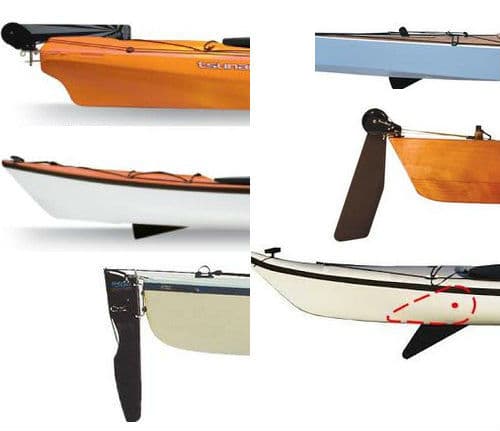
Rudder? Skeg?
A rudder is a long, narrow fin-like blade that extends down into the water off the stern end of a kayak. It can be moved side to side thereby affecting the flow of water along the blade, applying a force to the blade that turns the boat in the direction of that force (rudder angled to the right, boat turns to right). A rudder is designed to be deployed fully, and can be swept side to side by operating foot pedals in the cockpit.
A skeg is a fin that is centered on the keel of a boat, either fully back at the stern or slightly forward of the stern – along the aft section of the keel. Some skegs are retractable (swung up and housed within the hull when not deployed); others are incorporated into the design of the keel. A movable skeg can be deployed part way or fully up/down - but not sideways.
Maneuvering Aid
One technique for keeping a boat on course when it's being pushed to the left or right (wind, waves, current) is to alter each paddling stroke on the affected side to push the bow back onto course (boat going left, paddle harder on that side to push the bow back to right). That often works for short stretches but doing so for a long distance can be very tiring. In a situation such as this, a rudder can be offset a bit to the right to help keep the boat going "straight" while maintain equal stroking on both sides of the kayak. In this regard, a rudder is a helpful tool. It may be a matter of semantics but the rudder isn't actually being used to "steer" the boat, it is being used to adjust an action of the boat thereby enabling you to steer it without making exaggerated paddling strokes.

There are times, however, when a rudder actually is used to steer the boat. Kayak fishing often necessitates drifting into area to cast in a particular direction. Hands-free maneuvering of a drifting kayak is achieved by steering using the foot pedals to move the rudder as needed. Using binoculars or a camera while drifting benefits from the steering advantage of a rudder system as well.
Affects of Skeg Position in Crosswinds
The use of a skeg is predominantly for anchoring the stern against side force influences. The extent to which a skeg is deployed – the amount of fin surface exposed beneath the keel – affects the resistance or force the stern has against being pushed sideways. Retracted skegs offer no resistance and thus tend to cause the stern to swing off line from the bow. Conversely, a fully deployed skeg can anchor the stern more than the bow, causing the bow to swing. Varying the amount of exposed skeg therefore affects those movements proportional to the exposed surface area of the skeg.
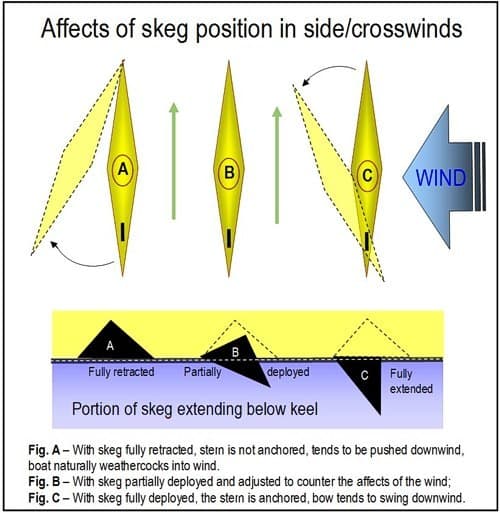
Pros and Cons of a Rudder
Rudders are operated by a cable and foot pedals system. The cable, attached to the rudder, runs through a tube opening in the aft deck, through a channel and is connected to a foot pedal or sliding track in the cockpit. The cable is on a U-shaped loop: push forward on one side, the other side moves in the opposite direction. Pushing right, pulls the cable on the right side of the rudder causing it to swing to the right, and ultimately making the kayak go to the right as well. Simple and direct.
The trade-off comes from the softness in the foot pedal, a spongy feeling that compromises a solid contact point while paddling. The paddler can't get a solid foot brace with a non-firm pedal. This limitation has been addressed by the development of a "gas pedal" style of rudder foot control. It enables the base of the pedal to be fixed at a proper length for the individual paddler but the rudder cable is attached to a movable portion of the pedal enabling the paddler to have a solid foot hold and still be able to manipulate the rudder cable. "Gas Pedal" rudder systems offer a pedal component that is fixed in place, but either a portion of the pedal or the entire pedal itself also pivots to operate the rudder via the cable connection. This affords the paddler both solid foot bracing support and a movable rudder pedal.
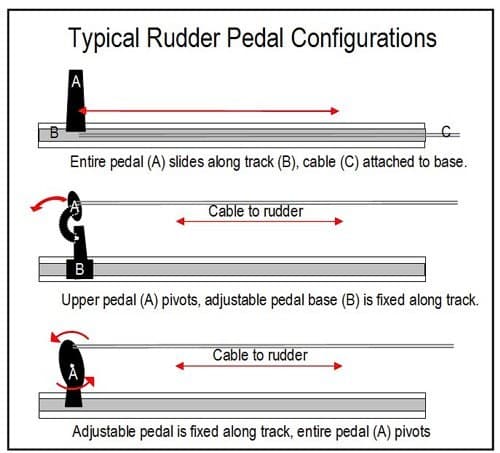
Because of all the hardware and moving parts, a rudder system is more prone to damage and requires steady maintenance. Sand and other particles can jam movements, and blades can be dinged (I had to straighten a metal rudder blade once by banging it back into shape with a fist-sized rock!).
Perhaps a more subtle but long-term negative about rudders is the over dependency by paddlers who use them to steer. Regardless of the virtues of a rudder, a foundation in solid paddling techniques should always be a priority.
Typically double kayaks use a rudder throughout the paddling activity. It's been my experience that this is due primarily to counter the paddler's "steering" mayhem in the forward cockpit! Another "steering" use can be applied when several kayaks raft up or perhaps when a kite has been deployed and one’s hands are busy.
Pros and Cons of a Skeg
A fixed skeg, one built into the keel of the boat is an integral part of that hull and the paddler will learn how to handle that craft accordingly. An adjustable skeg offers a paddler an opportunity to fine-tune the effects of the environmental dynamics playing against his/her craft at the moment. The skeg's altering affects on how the boat handles can be adjusted through experience to best compensate for those conditions. Because there is no lateral movement in a skeg, there is no need for movable foot braces so foot support is not compromised.
Like the rudder, adjustable skegs can become jammed due to sand and other particles. Also an adjustable skeg, when retracted, swings up into a sleeve inside the aft section of a kayak. That protrusion limits the stowage dimensions inside that compartment.
Final Word
Having a rudder on a kayak can be a convenient aid to maneuvering and during certain activities, actual steering. It should be used to augment good paddling technique - never to replace it. If you opt to buy a kayak without a rudder, check to see if you can retrofit that model's rudder or install an after-market brand. Some kayaks come with fittings, holes and channels already molded into the hull. You may have to measure and drill holes in the hull to outfit other hulls with a rudder assembly.
As with other options, check out the rudder system before you buy. On-water demo days are one of the best ways to see if a particular set-up works for you. Make sure you have solid foot bracing capabilities. Check, too, on the quality of the rudder mechanisms: cable connections, adjustable/locking pedals, and the mechanics of the rudder movements. A rudder has more moving parts than anything else on your kayak (except you!) so make sure it's built well and works smoothly.
Safe paddling! Have fun out there!
Tom Watson is an avid sea kayaker and freelance writer. For more of Tom's paddling tips and gear reviews go to his website: www.wavetameradventures.com. He has written 2 books, "Kids Gone Paddlin" and "How to Think Like A Survivor"that are available on Amazon.com.
Related Articles
"Seven days, three rivers, one kayaker: Nouria Newman kayaks solo in India! Nouria Newman combines a…
Whenever you're paddling, there's safety in numbers and so it's generally not a good idea to paddle…
Although kayaking is something that almost anyone can enjoy, kayaking in windy conditions presents…
Even the best paddlers goof up occasionally, which is why they take small stuff so seriously. When…


